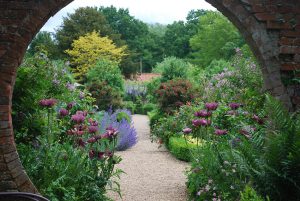Lawn care involves many things, including clearing the lawn of fallen leaves and branches, removing pests, and watering properly. However, another thing that has a huge impact on the quality and health of your lawn is elements that may interrupt or decorate it. Many homeowners love the look of stone and other hardscape elements on their lawn. Selecting the best hardscape materials may be hard if you do not know which item is best for grass lawns. Maximizing the design while keeping the places where grass can grow is ideal. Here are four elements that will bring out the vibrant green in your yard and minimize how much you need to mow.
Pavers
One fantastic type of hardscaping involves the use of pavers, or paving stones. While brick is dark and striking, concrete is more even in tone and lighter for a brighter garden area. Concrete paving stones look beautiful as a border around flower beds, miniature streams, fish ponds, and fountains. These materials have few holes where grass can grow. Brick pavers provide contrast and interest, working well for fire features and outdoor kitchens. For a rustic design, brick is the better option. Pavers can also provide natural barriers between lawn features that prevent your yard from getting overgrown or cluttered with rotting vegetation that can attract pests.
Natural stone walkways
Natural stone walkways are another way to divide up your lawn and functionally prevent people from trampling your grass. Some of the most serene hardscape designs incorporate stunning natural elements like limestone or slate. When you want to create a footpath, these materials work well with grout or gravel to minimize weed and grass growth between the pieces. Natural elements can be cut to any size or shape you want. Plus, these materials have unique veining and coloring that will provide a striking design that no one else will have in their yard. And of course, walkways provide natural ways to cut across your lawn that hopefully will prevent people from walking and crushing tender shoots underneath their feet.
Gravel
Instead of mulch, you can put gravel around your trees, shrubs, and flowers. This material is much better at restricting grass and weed growth in larger areas. You can use this material with garden mesh to create an impenetrable barrier. The best thing about gravel is it will not mold or fade. You do not have to replace it each year. This means that it will protect your greenery for a long time.
Ceramic pots and accent pieces
Sometimes, hardscaping is as easy as throwing a large pot in a space you do not want to mow. Fill the pot with your favorite flowers or vines and let it flourish. The grass will grow around the pot bottom, so you may want some decorative rocks or gravel around it. Otherwise, just set your pot, fill, and love.
You can paint the pots any color you want. Adding a mosaic tile band or coating the entire pot with these tiles will provide a fantastic design element. You can use the colors in the tile to create bright pops around the yard.
Hardscaping means designing an area that is stunning with little requirements for care. These four elements can help you create a fabulous yard. The best part is you can enjoy the greenery in smaller doses if you have allergies or little time to mow and get rid of weeds by selecting your favorite plants to keep. You can use the hardscaping to accentuate the look of the greenery and blend the pieces to make them look seamless and more natural.

